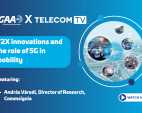
About us
Connected Mobility for People, Vehicles and Transport Infrastructure
The 5G Automotive Association (5GAA) is a global, cross-industry organisation of companies from the automotive, technology, and telecommunications industries (ICT), working together to develop end-to-end solutions for future mobility and transportation services. Created in September 2016, 5GAA has rapidly expanded to include key players with a global footprint in the automotive, technology and telecommunications industries. This includes automotive manufacturers, tier-1 suppliers, chipset/communication system providers, mobile operators and infrastructure vendors.

5GAA was created to connect the telecom industry and vehicle manufacturers to develop end-to-end solutions for future mobility and transportation services.
Mission
5GAA bridges the automotive and telecommunication industries in order to address society’s connected mobility needs, bringing inclusive access to smarter, safer and environmentally sustainable services and solutions, integrated into intelligent road transportation and traffic management.
A visionary roadmap
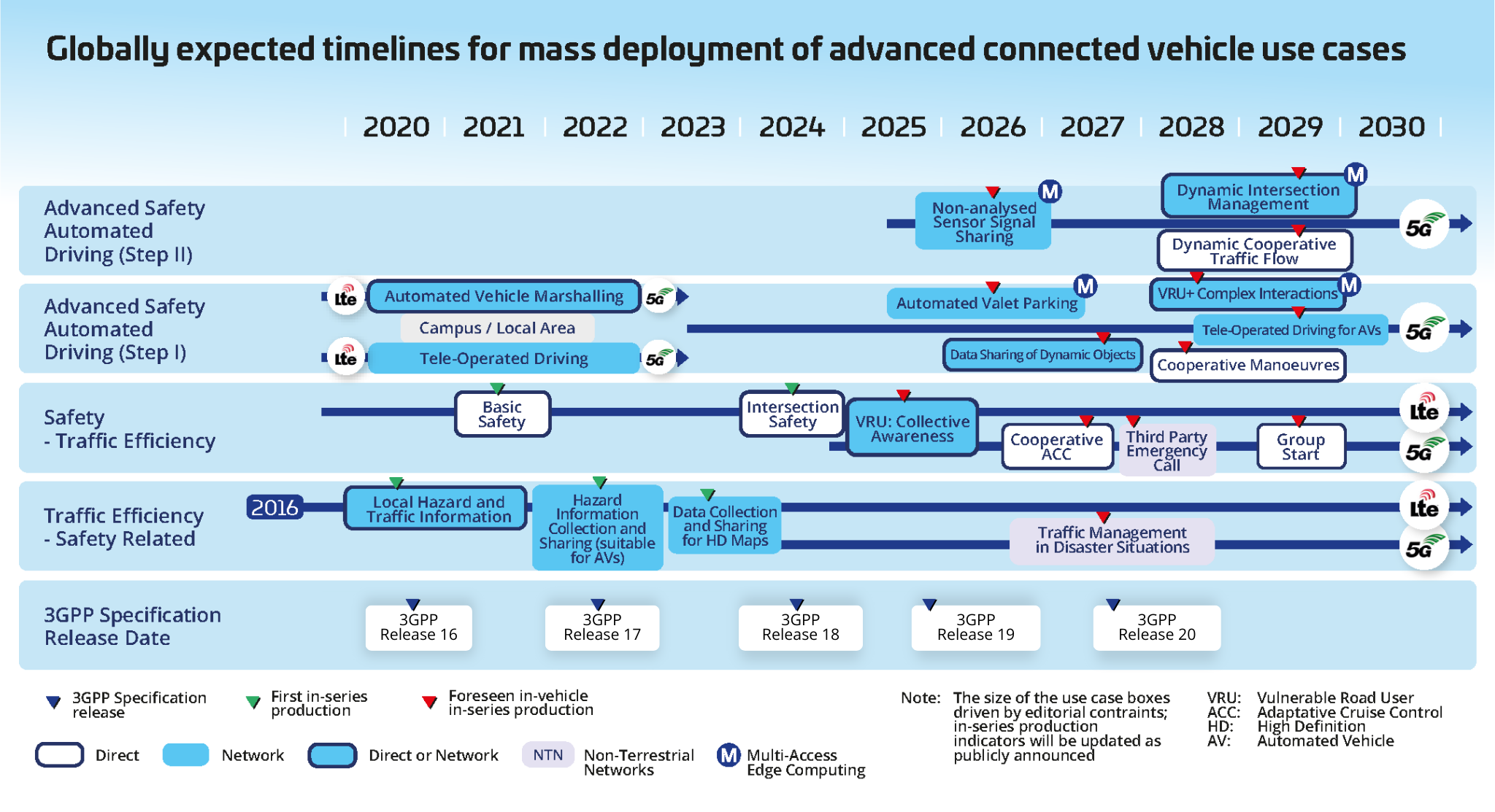
What we do
5GAA is addressing today’s mobility key challenges. With C-V2X technology, 5GAA will revolutionise the mobility ecosystem and the way drivers interact with the world. 5GAA’s ambition is to improve the overall transportation industry to make it safer, greener and more efficient for vehicles, road users and the surrounding infrastructure.

5GAA has defined 4 strategic pillars designing the short and long term goals in very diverse domains contributing to the same ambition: Connected Mobility.
Latest publications
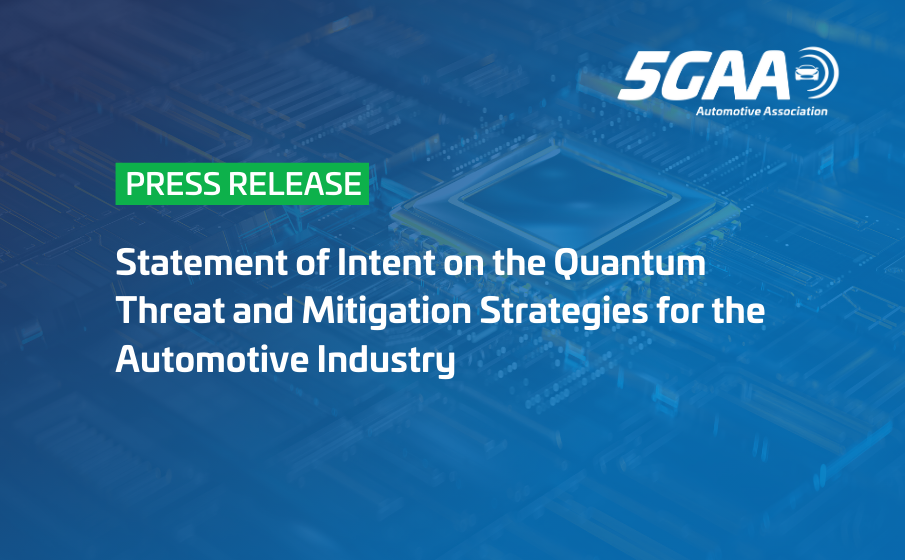
5GAA Issues Statement of Intent on the Quantum Threat and Mitigation Strategies for the Automotive Sector
As part of its cooperation agreement with GSMA, 5GAA intends to work with the GSMA Post-Quantum Telco Networks (PQTN) Task Force to explore the impacts that quantum computing and the migration to post-quantum cryptography has on the connected automotive sector and its customers. Through this cooperation, 5GAA and the GSMA PQTN Task Force will gain insights to help both the telco and automotive industries strengthen the future of connected automotive security with post-quantum cryptography and crypto-agility. The rapid evolution of automotive E/E architecture and Software-Defined Vehicles has transformed modern vehicles into highly connected computing platforms, enabling advanced functionalities such as Vehicle-to-Everything (V2X) communication, autonomous driving, and over-the-air updates. This increasing connectivity significantly expands the attack surface for bad actors, making vehicles more exposed to cyber threats.
Read and download the full statement here.

5GAA Workshop ‘Enabling New Services with Next Generation ITS in Japan’
5GAA is hosting its upcoming workshop, ‘Enabling New Services with Next Generation ITS in Japan,’ in the context of its 29th Meeting Week. The event will take place on February 1st at the Hilton Tokyo, between 9AM and 1PM JPT.
In response to the recent release of Japan’s Frequency Reorganisation Plan by the Ministry of Internal Affairs and Communications, assigning the 5.9 GHz spectrum to V2X for next-generation ITS, this workshop aims to explore the potential implications and opportunities. 5GAA welcomes the decision, which aligns with global spectrum allocation.
The workshop will delve beyond technicalities, offering insights into recent government activities, ongoing development efforts, and expectations for new ITS in Japan. It will also serve as a convergence point for local stakeholders and global industry players, encouraging collaboration and setting the stage for a fruitful discussion Japan’s future in this domain.
Find the full programme here. More information available on our News section.

Connected mobility
C-V2X in action
Immerse yourself in the possibilities
The C-V2X technology revolutionises the mobility ecosystem and how drivers interact with the world. It is essential to redefine transportation by providing real-time, highly reliable, and actionable information flows to enable safety, mobility and environmental applications.
5GAA established C-V2X as the critical technology to achieve the level of connectivity required for V2X communication and to be a disruptive force in the automotive market.
C-V2X Testing and Deployment
Following extensive validation testing, off-the-shelf LTE-V2X chipsets, modules, On-Board Units (OBU) and RSU (Roadside Units) have been globally available from multiple vendors since 2018.
These devices feature LTE-V2X direct communications (PC5) and LTE-V2X mobile network communications (Uu). The latest generation of devices features 5G-V2X mobile network communications (Uu) based on 3GPP Release 15.
5GAA regularly compiles an overview of the C-V2X Devices, which we understand are already publicly available on the market (the latest issue in November 2021). This overview is based on publicly available information and does not necessarily include factory-fit telematics/V2X boxes directly under contract with automakers.
The start of in-vehicle commercial deployment (i.e. type-approved vehicles) has begun in 2020-2021. A significant testing schedule is already underway for 5G-V2X, the next generation for cellular technology-based communications solutions, with more than 20 trials and early deployments globally.
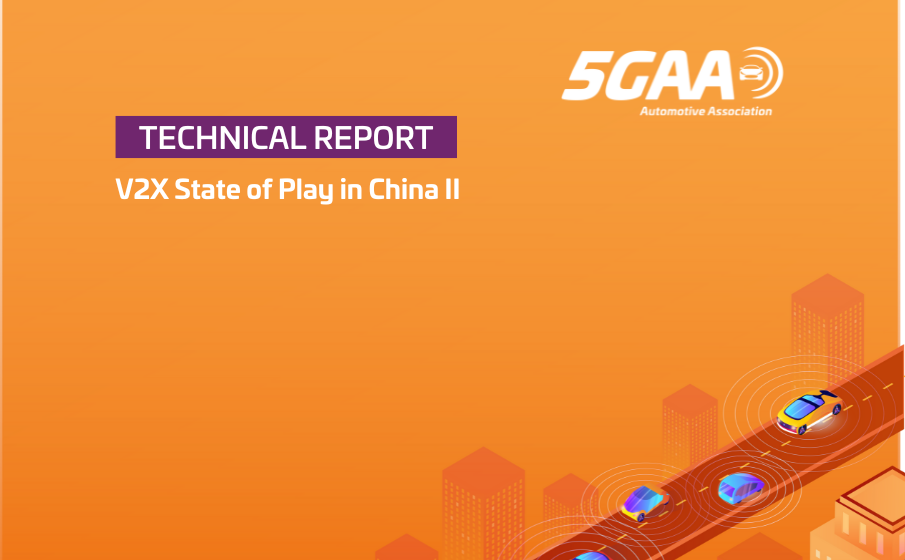
V2X State of Play in China II
This Technical Report (TR) covers Vehicle-to-Everything (V2X) developments in China from 2022 to 2024. The TR explores ‘C-V2X policies and regulations in China’, ‘C-V2X standardisation in China’, and ‘C-V2X pilot and demonstration areas in China’. The results and conclusions of this report will effectively reinforce overall comprehension by 5GAA members of the state of play of V2X in China, and then provide more effective C-V2X solutions, which will affect the global development of the Internet of Vehicles.
Download the full document here.

Experience the Future of Connected Mobility at MWC 2025 with 5GAA
Join us at Mobile World Congress (MWC) 2025, taking place from March 3-6 at the Fira Gran Via in Barcelona, to explore the latest advancements in connected-vehicle technologies.
Many connected-vehicle services are becoming mission-critical. Customers want ubiquitous connectivity. Today it comes via the cellular networks, tomorrow also via satellite communications. Networks also need to be resilient, or available even under exceptional conditions such as disaster scenarios or periods of overwhelmingly high network usage.
The 5G Automotive Association (5GAA) brings together leading players from the telecommunications, automotive, and technology industries to drive innovation in mobility. This year, At MWCB 2025, 5GAA members will showcase the latest connected vehicle technologies including ubiquitous, reliable, and low latency connectivity using cellular, NTN, multi-access edge computing, and C-V2X Direct.
Visit the 5GAA booth in Hall 6, Stand 6E64, and tour our members’ stands to see firsthand how we are shaping the future of mobility.
Exclusive Press Tour
Media representatives are invited to join a guided press tour, featuring insights from 5GAA CTO Maxime Flament and representatives from BMW and Verizon, along with exclusive visits to the stands of Harman, Deutsche Telekom, Ericsson, Huawei, MediaTek, Nokia, Keysight Technologies, Anritsu, and Rohde & Schwarz. Journalists interested in participating can register by contacting us at marcom@5gaa.org.
5GAA at MWC 2025
Our CTO Maxime Flament will speak at several key sessions throughout the week, including:
– Digital Infrastructure of the Future: Shaping Europe’s Competitive Edge
– Security Summit: Post-Quantum Cryptography and its Relevance to Connected Mobility
– GSMA’s Global 5G Alliances Summit
– GSMA’s Smart Mobility Summit: Building the backbone: The Infrastructure Behind Modern Mobility
For more information, meeting requests, or press inquiries, contact the 5GAA Marketing and Communications team at marcom@5gaa.org.

Connected Mobility
Sustainability
Sustainability benefits of C-V2X
Cellular Vehicle-to-Everything, or C-V2X, communications will make transportation not only safer and smarter but also more sustainable.
Sustainability has three dimensions: environmental, social and economic.
C-V2X ticks all three boxes:
- Environmental: By helping to make every trip smarter, safer and more efficient, C-V2X helps reduce congestion and accidents, thereby reducing air pollution, noise pollution and energy use.
- Social: Saving lives and avoiding injuries are clear social benefits. By enabling real-time communication between pedestrians, cyclists, traffic infrastructure and moving vehicles, including motorcycles and electric scooters, C-V2X will help avoid accidents that otherwise would result in injuries and deaths.
- Economic: By enabling more efficient mobility, C-V2X will save people and employers billions of man-hours currently wasted in traffic jams. Those man-hours can then be dedicated to more rewarding activities.
C-V2X also enables the growth of autonomous mobility, which in turn offers even greater sustainability benefits, for example mobility-as-a-service offerings.
To learn more, watch the short video or scroll down for more details.
C-V2X and Sustainability in detail
ENVIRONMENTAL BENEFITS

- Transport still represents about 25% of Europe’s total CO2 emissions. By helping to make every trip smarter, safer and more efficient, C-V2X helpsreduce congestion and accidents, thereby reducing energy use, noise pollution and air pollution.
- C-V2X can help all vehicles operate and deliver people and goods more efficiently, thereby reducing pollution and optimizing the use of valuable energy resources.
- INRIX calculated that each second of reduced delays at traffic signals across the United States would translate to an annual reduction of 800,000 metric tons of CO2.
- Connected vehicle technology can help electric cars calculate an energy-optimised route to a charging station that’s not necessarily the fastest or nearest but requires the least energy to reach.
- Examples of environmental benefits enabled by C-V2X technologies include:
- Current technology permitting smarter routing for all vehicles in both urban and rural areas, for example via automated traffic routing, road, bridge, tunnel and parking availability updates and smart parking.
- Future technology permitting “green waves” for emergency vehicles, cars, trucks, lorries and other vehicles instead of stop-and-go traffic.
- Future technology facilitating manoeuvres and cooperation in traffic.
- For more detailed information, please see TNO’s report for 5GAA on the Environmental Benefits of C-V2X.
SOCIAL BENEFITS

- By enabling real-time communication between pedestrians, cyclists, traffic infrastructure and moving vehicles, including motorcycles, C-V2X will help avoid accidents that otherwise would result in injuries and deaths.
- According to the World Health Organisation, there were 1.35 million traffic deaths globally in 2016, the latest year for which global data are available. Road traffic deaths are a leading cause of death among young people, in particular.
- In the European Union, there were about 20,608 road deaths in 2023, or about 46 road deaths per million inhabitants.
- In the United States, an estimated 40,990 people died in road accidents in 2023. The United States Department of Transportation has set an ambitious goal of zero traffic deaths, in part by leveraging advanced technologies to prevent accidents in the first place.
- It says: “The U.S. Department of Transportation’s National Roadway Safety Strategy specifies that zero is the only acceptable number of deaths and serious injuries on our roadways. USDOT is committed to taking substantial, comprehensive action to achieve this goal.”
- By providing real-time hazard notifications and enabling connected cooperative driving, C-V2X makes transportation safer for all road users, including cyclists. As C-V2X makes the roads safer, more people may feel confident in choosing cycling as their primary mode of transportation.
- A U.S. DOT pilot study demonstrated that C-V2X technology can prevent accidents and injury for vulnerable road users.
- Green waves and corridors for emergency vehicles can help save lives and reduce injuries, allowing people to lead longer, healthier and more fulfilling lives.
- Response times are critical for emergency vehicles and first responders to save lives. A 2020 study showed that “green waves” at traffic lights could reduce response times by as much as 30% with little impact on overall traffic conditions.
- By enabling more efficient mobility, C-V2X will save commuters billions of man-hours currently wasted in stressful traffic jams.Those man-hours can be dedicated to more enjoyable and rewarding activities such as doing sports, hobbies, volunteering, education or spending time with friends and family.
- In Europe, the average driver in some cities loses more than 150 hours per year stuck in traffic jams.
- Americans lost as much as 3.4 billion hours in traffic in total in 2021.
- C-V2X helps connect other modes of transport with one another to facilitate a real multi-modal transportation system.
ECONOMIC BENEFITS

- By enabling automated driving and mobility as a service, C-V2X will help create new products and services that help drive more sustainable economic growth.
- For example, anonymous data collected through C-V2X can help governments and policymakers develop more effective infrastructure maintenance programmes and traffic plans.
- By enabling more efficient mobility, C-V2X will save employers and entrepreneurs billions of man-hours currently wasted in traffic jams.Those man-hours can then be dedicated to more rewarding activities.
- For commercial vehicles, C-V2X can help optimise delivery routes and schedules and reduce the number of empty or partially loaded trips. Efficient route management reduces energy use and pollution.
- The deployment of C-V2X technologies in vehicles can increase demand for 5G and future networks, each of which will be more energy-efficient than the technologies they replace.
Want to learn more?
If you want to learn more about the timeline for the introduction of next-generation C-V2X communications technologies, including those with clear environmental benefits, please see our latest C-V2X technology Roadmap here.
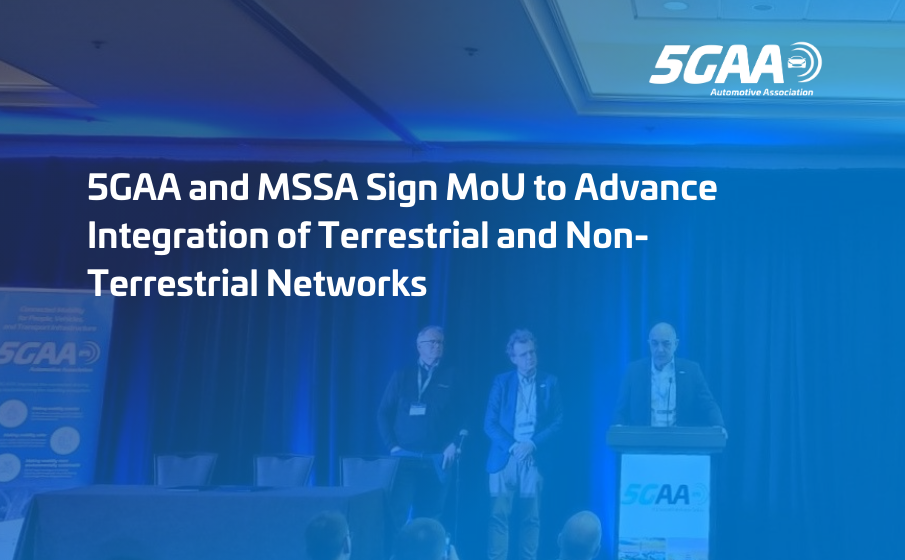
5GAA and MSSA Sign MoU to Advance Integration of Terrestrial and Non-Terrestrial Networks
The 5G Automotive Association (5GAA) has signed a Memorandum of Understanding with the Mobile Satellite Services Association (MSSA) to enhance global collaboration in integrating terrestrial and non-terrestrial networks (NTNs). The agreement was formalised during the Closing Ceremony of the 5GAA Meeting Week in Washington, D.C.
This strategic partnership establishes a framework for cooperation in key areas, including technological research and development, spectrum management, and the convergence of satellite and cellular networks. By leveraging 5GAA’s expertise in automotive connectivity and MSSA’s leadership in standards-based satellite networks, the collaboration aims to improve the reach, resilience, and efficiency of mobile connectivity for mobility and transportation applications.
The integration of NTNs with existing cellular networks is expected to play a crucial role in advancing connected and autonomous driving, enhancing road safety, and optimising intelligent traffic management. This partnership will also support the deployment of next-generation communication technologies such as Cellular Vehicle-To-Everything (C-V2X), essential for future mobility solutions.
Through this collaboration, 5GAA and MSSA will work together to share knowledge, coordinate technical and regulatory activities, and foster the development of innovative applications for both the automotive and broader mobile industries. The agreement highlight a shared commitment to scalable, standards-based solutions that address evolving global connectivity needs.
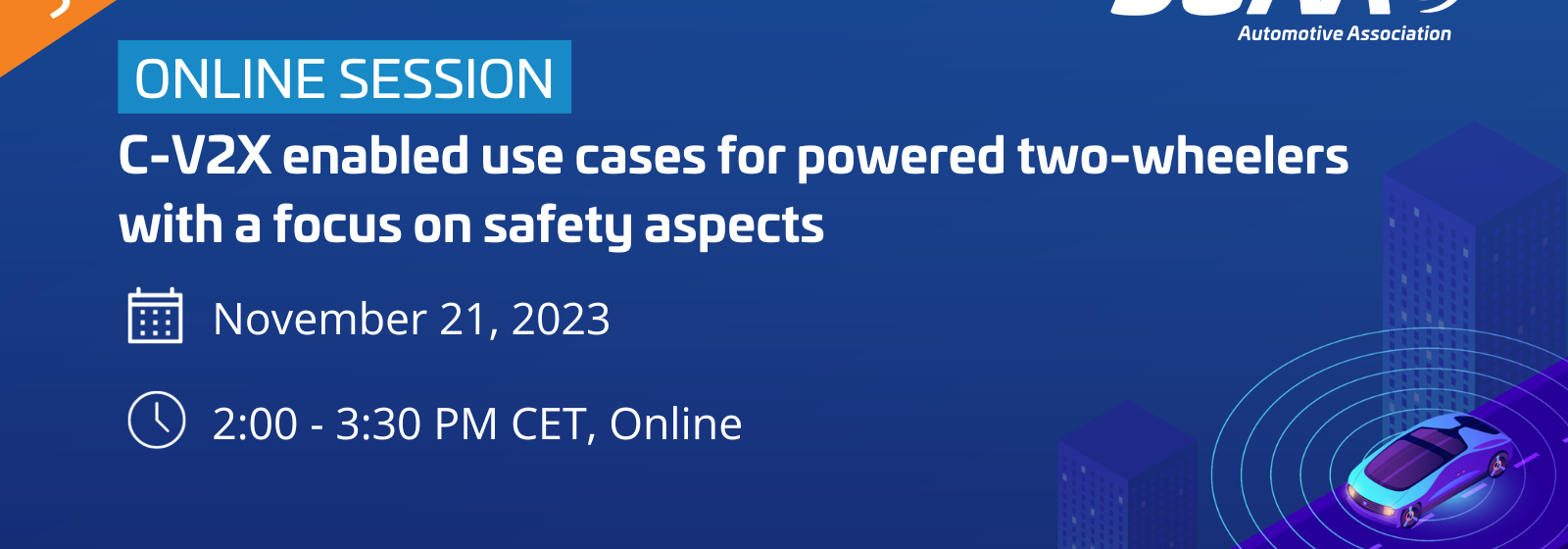
5GAA online session on C-V2X enabled use cases for powered two-wheelers with a focus on safety aspects
The 5G Automotive Association is pleased to invite you to our online session on the “C-V2X enabled use cases for powered two-wheelers with a focus on safety aspects.”
Following the recent publication of a technical report on the Connected Powered Two-Wheelers (CPTW) Work Item, the 5G Automotive Association together with the Connected Motorcycle Consortium (CMC) is hosting an online session on Tuesday, 21 November, from 14:00 to 15:30 PM (CET).
The session will be led by Ehsan Moradi Pari (Honda), Matthias Moerbe (Bosch), and Thomas Jaeger (DEKRA) on the 5GAA side, and CMC experts around Hennes Fischer (Yamaha), Alina Kuttler (KTM) and Dennis Gerber (BMW) who were involved in this Work Item. The speakers will present the highlights of the CPTW technical report on C-V2X-enabled powered two-wheeler use cases, mainly focusing on safety aspects.
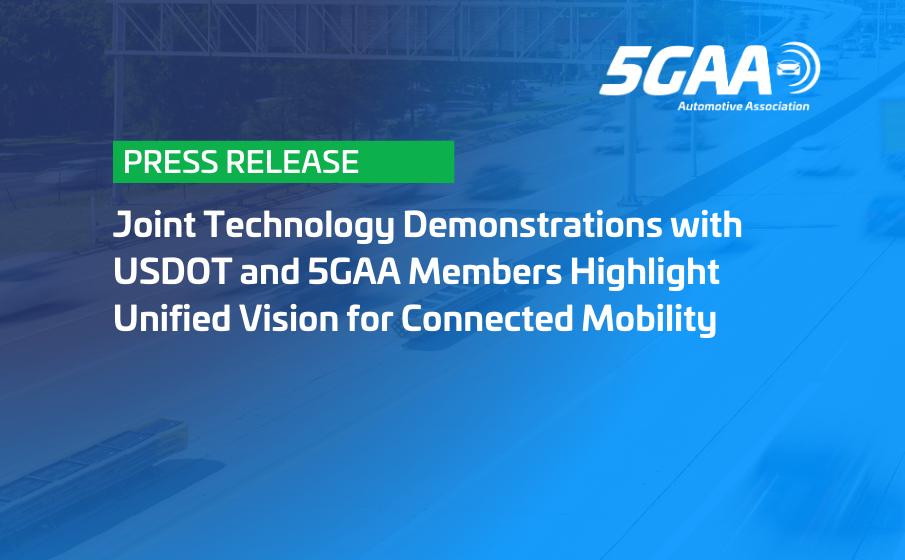
Joint Technology Demonstrations with USDOT and 5GAA Members Highlight Unified Vision for Connected Mobility
Washington, D.C., 6 February 2025 – For the first time, the U.S. Department of Transportation (USDOT) and members of the 5G Automotive Association (5GAA) have partnered to showcase the complementarity of Cellular Vehicle-To-Everything (C-V2X) direct and mobile network communications at the Federal Highway Administration’s Turner-Fairbank Highway Research Center.
The live demonstrations illustrated the potential of connected-vehicle technologies to make American roads safer and more efficient. This public-private initiative also outlined the benefits of interworking communication modes for a unified transportation system.
“5GAA commends USDOT for its leadership in advancing V2X technology through government-industry collaboration, critical for nationwide deployment,” said 5GAA Chairman Christopher Voigt. “We applaud USDOT’s commitment to seizing the full safety potential of V2X by integrating direct and mobile network communications to achieve 360° awareness.”
Participants had the opportunity to experience several use cases:
- Verizon showcased near real-time alerts enabled by C-V2X mobile network communications and mobile edge computing (MEC). Demonstrated capabilities included connected signalized intersection and delivery of pedestrian alerts, variable speed warnings, and weather warnings.
- Audi, in collaboration with Spoke and the Coalition for Cyclist Safety, used C-V2X direct communications to address safety scenarios that often result in cyclist fatalities. The seamless integration of aftermarket solutions and in-vehicle systems is a clear example of leading automakers’ increasing interest in this technology.
- Autotalks illustrated how C-V2X direct communications can prevent same-lane accidents: in their demo, a car swerved abruptly to avoid a stopped bicycle, showcasing the system’s potential to protect cyclists outside intersections.
5GAA also gathered industry and government leaders to identify main drivers for deployment, such as the reauthorization of federal transportation funding. The event underpinned the critical role of C-V2X in achieving USDOT’s National Roadway Safety Strategy targets, as well as the industry’s commitment to help implement the National V2X Deployment Plan released in August 2024.
With this, the foundation is laid to leverage the existing tens of millions of connected road users and accelerate the nationwide rollout of connected-vehicle and connected-road infrastructure technologies, bringing us closer to the shared vision of zero traffic fatalities on American roads.
About 5GAA
The 5G Automotive Association (5GAA) is a global, cross-industry organization of more than 110 members, including leading global automakers, Tier-1 suppliers, mobile operators, semiconductor companies, and test equipment vendors. 5GAA members work together to develop end-to-end solutions for future mobility and transport services. 5GAA is committed to helping define and develop the next generation of connected mobility, automated vehicles, and intelligent transport solutions based on C-V2X. For more information about 5GAA, please visit www.5GAA.org.
For further information please contact:
5GAA Marketing & Communications – Marcom@5GAA.org










